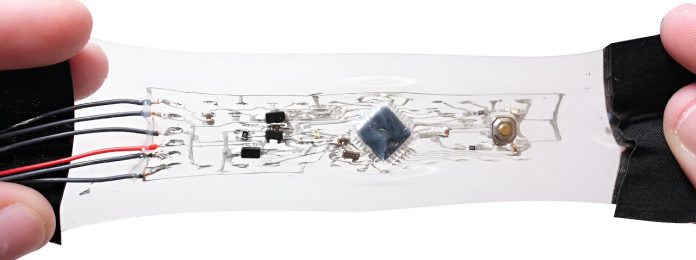
Soft robots and wearable devices hold great potential for many uses, from search-and-rescue missions to medical therapies like helping people recover from injuries.
However, making these devices both functional and flexible has been a big challenge.
Electronics are typically rigid, and it’s hard to integrate them into soft, stretchable robots or wearable devices.
Researchers in Prof. Rebecca Kramer-Bottiglio’s lab at Yale University have made a significant breakthrough in this field.
They’ve developed complex, stretchable electronics that can expand far beyond their original size while still functioning properly.
This advancement, published in Science Robotics, could make soft robots and wearable devices more practical and versatile in the future.
One of the main challenges in building soft robots is the need to combine rigid electronics with soft materials.
Most robots use traditional electronics like Arduino controllers, which are stiff and don’t stretch.
Designers usually try to place these controllers in parts of the robot that won’t move much, but this limits how flexible the robot can be.
The researchers in Kramer-Bottiglio’s lab solved this problem by creating stretchable versions of Arduino circuits.
These circuits can be embedded directly into soft robots and can stretch up to three to four times their original size while still working perfectly. This is a major step forward because it allows robots to remain flexible without sacrificing computing power.
What makes this development even more exciting is that the process is easy to reproduce and scale. The researchers designed their stretchable circuits using a simple method that doesn’t require special equipment or materials.
They started with a gallium-based liquid metal, which they turned into a paste by stirring it with oxygen. This paste is then applied to a laser-cut paper mask to create the circuit pattern. After the mask is removed, the components are placed, and the circuit is sealed.
The entire process is open-sourced, and anyone can access the instructions on GitHub.
The researchers applied their stretchable electronics to several different Arduino devices, including the Arduino Pro Mini and the Arduino Lilypad. They even made versions of sensors like the Sparkfun Sound Detector and the RGB Gesture Sensor, showing just how adaptable the system can be.
One exciting example of the technology in action is its use in soft robots. The researchers embedded the stretchable circuits into a robot that moves on four legs, showing that the circuits don’t interfere with the robot’s ability to morph and move.
They also tested the circuits in wearable devices, placing them on high-stretch areas like the elbow. Despite the constant movement, the electronics stretched and worked perfectly.
This innovation opens up a world of possibilities for soft robots and wearable technology. By making electronics stretchable, researchers have paved the way for more practical and flexible devices that can be used in many different fields, from rescue missions to medical care.



